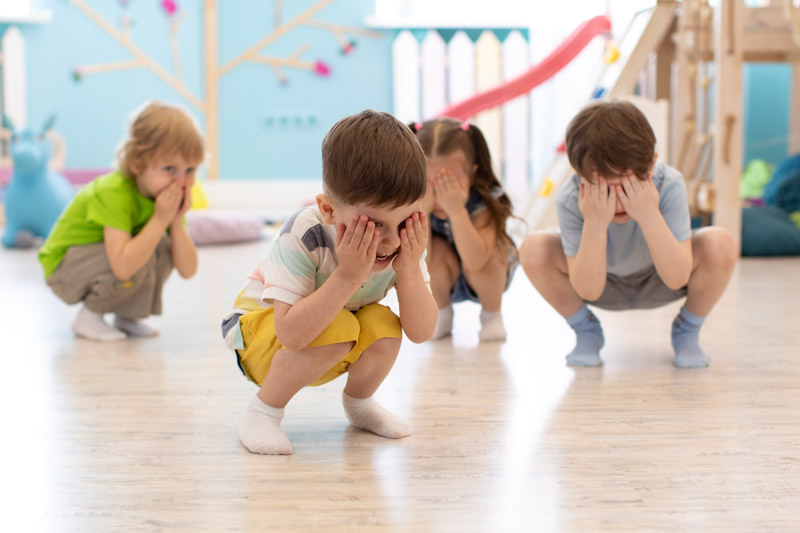High-Tide, Low-Tide Game
Overview
Children learn more about their special species and others as they explore life cycles and tide-related behaviors.
Focus Question
- What different things do marine animals do at high tide and at low tide?
Enduring Understandings
- Plants and animals can be sorted into groups based on different characteristics.
- People use the plants and animals of the seas and rivers in different ways.
Engagement
10 minutes
Read a book about the tides. Ask students: What do you know about the tide? What do you notice when the tide is high? What do you notice when the tide is low? What do you think happens to tide-pool animals and plants when the tide is high? What do you think happens to plants and animals when the tide is low or out?
Exploration
10 minutes
Tell your students: We are going to play a game called: High-tide, Low-tide.
I’ll say the name of an animal that lives near the tide line. It will be an animal that spends some of its life exposed at low-tide and some of its life covered with water, at high-tide. To begin with I’ll describe how the animal moves and feeds at high-tide. Then I’ll describe how the animal protects itself and behaves at low-tide.
Here’s an example: A Barnacle. You are a barnacle. You have glued your shell to a rock and you sit upside down in your shell house. Each shell house is made of six hard, crusty, plates. When the tide is high the barnacle opens its movable shell plates and throws out its curled, feathery legs. It uses its curled feathery legs to sweep the sea soup for tiny plants and tiny animals and kick them down into their mouths. At low-tide the barnacles show no movement or sign of life. The six hard, crusty shell plates close up tight. The barnacle’s shell makes a moist house and keeps the animal cool. The barnacle sits upside-down in its cool shell house with its head cemented to the bottom and its long feathery legs curled up tight.
When I say: high-tide show how a barnacle behaves at high tide. When I say: low-tide show what a barnacle does when the tide is low.
Here’s another example: A Limpet. At high-tide the limpet moves about scraping and scraping the rocks with its tongue. A limpet tongue is like a long ribbon covered with very fine teeth. The limpet creeps along scraping and eating on the thin layer of tiny green plants that covers the rocks. At low-tide, a limpet out of seawater does not scrape the rocks for tiny green plants. It pulls its head and the two long feelers inside its cone-shaped shell house. With its wide muscular foot it plasters itself to the rock with very tight suction. The limpet’s cone-shaped shell protects it from hungry crab, sea stars and shore birds and it makes a moist pocket for the animal inside its shell.
When I say: high-tide show how a limpet behaves at high tide. When I say: low-tide show what a limpet does when the tide is low. “
Explanation
10-20 minutes
After students have acted out the examples, ask them to think about the marine animals and plants that they’ve learned about and what they would be doing at high tide and low tide. What are their unique ways of ‘eating and moving’? Ask students to share what they know, and allow them to do more research if needed. Have each child draw a picture of a plant or animal at high tide and at low tide, in their science notebook, using the High Tide, Low Tide glue-in.
Elaboration
10-20 minutes
Invite students to ‘teach’ and lead this game. Allow a student to be the leader and describe how their animal behaves at low-tide and high-tide, while other students act it out.
Evaluation
Observe the students’ work in their science notebooks and their actions during the activity.
Teacher Needs
Teacher Prep
Do research and gather information about local marine/aquatic plants and animals.
Acquire and organize books and materials. Make up examples of a large animal sculpture, a wheel book, and a riddle to show students.
Materials List
- Alphabet books to share with children for models
- 12 X 18 pieces of paper
- laminator
- spiral binding or 3 rings
- drawing and coloring materials (colored pencils, crayons)
- Books, field guides and/or posters showing local marine/aquatic plants and animals
- Science notebooks
- High Tide, Low Tide glue-in
- Large rolls or sheets of paper (variety of colors) and newsprint or newspaper
- Staplers, scissors, markers
- Room to manipulate tools and paper
- Construction paper
- Template and directions for the wheel book
- Brads
- Tag board and circle template
- “Everything Grows” book and/or song
- Life-cycle pictures to cut out
- A book about tides
Student Needs
Prior Knowledge
Students should know the ABCs, and have some prior experience with a class research project. They should be able to work with large paper and use tools for cutting and stapling. They will need to know how to use a paper fastener (brad).
Vocabulary
adult, answer, clues, cut, details, developing, draw, information, larva, life cycle, paint, research, riddle,staple, stuff, tide
Names of local plants and animals and their features.
Standards
Science GLEs Addressed
- A1, A2, C2, G3
[bws_pdfprint display=’pdf’]

